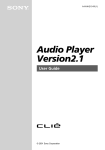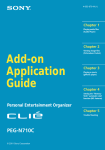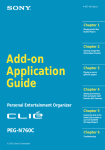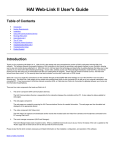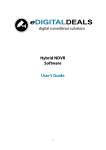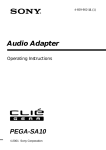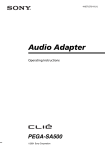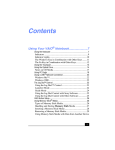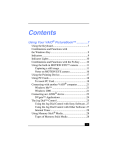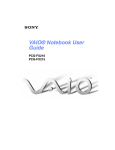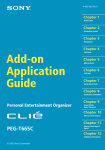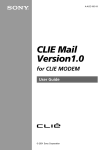Download Sony Clie Version 2.0 User's Manual
Transcript
A-AVN-200-11 Audio Player Version2.0 User Guide © 2001 Sony Corporation CLIE, Jog Dial, Memory Stick, the Memory Stick logo and PictureGear are trademarks of Sony Corporation. Microsoft and Windows are registered trademarks of Microsoft Corporation. Graffiti, HotSync, and Palm OS are registered trademarks, and the HotSync logo and Palm are trademarks of Palm, Inc. or its subsidiaries. QuickTime and the QuickTime logo are trademarks used under license. QuickTIme is registered in the U.S. and other countries. All other trademarks are trademarks of their respective owners. Before using this software, please read the Software License Agreement that is supplied with Sony handheld. ❒ Copying all or part of the contents of this software, sample images, and Operating Manual, or renting the software are prohibited by copyright laws. ❒ The Company is not liable for damage or loss resulting from the use of this software, or for any claim from a third party. ❒ The Company assumes no responsibility aside from the replacement of the media due to manufacturing fault. ❒ This software must not be used in a system other than that specified. ❒ The software specifications may be subject to change without notice. 2 Table of contents What you can do with the Audio Player .................................. 4 Playing audio files on your CLIE handheld ............................................ 30 To Listen to MP3 format audio files on your CLIE handheld ................................ 5 Connecting/attaching the supplied headphones ......................................... 30 To Listen to ATRAC3 format audio files managed by OpenMG Jukebox on your CLIE handheld ........................................ 6 Playing audio files ................................ 32 Installing Audio Player Ver.2.0 to your CLIE handheld ........................................ 7 Installing the software......................... 7 System requirements ............................. 9 Installing RealJukebox software .......... 10 Installing OpenMG Jukebox software .. 12 Importing audio files into your computer ............................................ 15 Playing in various modes ..................... 35 Selecting playback audio files (Pick up) 36 Switching the display view .................. 37 Switching the JogDial navigator function for Audio Player ..................... 38 Playing audio files with the supplied remote controller ................................. 40 Protecting your CLIE handheld from accidental pressure on its controls ....... 42 Switching the album (Custom album) .. 43 If you manage your audio files with RealJukebox software .......................... 15 Notes on “Memory Stick” media ....... 44 If you manage your audio files with OpenMG Jukebox software .................. 17 Notes on using OpenMG Jukebox ...... 47 Preparing your CLIE handheld, and placing it in the cradle ......................... 25 Transferring audio files from your computer to your CLIE handheld ....... 25 Transferring MP3 format audio files to your CLIE handheld .............................. 27 Notes on using RealJukebox .............. 46 What is “Check-in/Check-out”? ........... 47 On copyright protection ....................... 48 Differences between the HotSync operation and the check-in/out procedure ............................................. 49 Transferring songs from your CLIE handheld to your computer (Check-in) 50 Notes on playing audio files ................ 52 Restrictions on copyright protection by OpenMG ......................................... 54 Audio Player menu items ................... 55 3 What you can do with the Audio Player Audio Player is an application used to play audio files on your CLIE handheld. The following two versions of Audio Player are supplied with your CLIE handheld. This manual explains the operation for Audio Player Ver.2.0. • Audio Player Version 1.1: you can play ATRAC 3 format audio files managed by the OpenMG Jukebox software. This version of Audio Player is pre-installed; you do not have to install it. • Audio Player Version 2.0: you can play both MP3 and ATRAC 3 format audio files. In addition, you can use various playback displays such as Visual Effect view or List view. This version of Audio Player is supplied in the CD-ROM; you have to install it. Note You cannot use both versions of Audio Player at the same time. Audio Player Ver.2.0 supports MP3 files that meet following specifications • Format: MP3 ver.1, Layer 3 • Sampling frequency: 44.1 kHz • Bit rate: 32 to 128 kbps • File extension: .mp3 or .rmp A “Memory Stick” media is required to play audio files on your CLIE handheld There are two types of “Memory Stick” media. One is the normal “Memory Stick” media (purple), and the other is the “MagicGate Memory Stick” media (white). To play ATRAC 3 format audio files on your CLIE handheld, you have to use a “MagicGate Memory Stick” media. Otherwise, you can use normal “Memory Stick” media. For details, see “Notes on “Memory Stick” media” on page 44. 4 What you can do with the Audio Player To Listen to MP3 format audio files on your CLIE handheld You need to use; • Any software for managing MP3 format audio file on your computer. We supplied RealJukebox software for it with CD-ROM. • A “MagicGate Memory Stick” media (not supplied) or a standard “Memory Stick” media (supplied). To listen to MP3 format audio files with your CLIE handheld, please follow these steps. 1 Install Audio Player version .2.0 on your CLIE handheld. (See page 7) 2 Install any software for managing MP3 format audio file on your computer. We recommend RealJukebox supplied with CD-ROM. (See page 10) 3 Ready any MP3 audio files on your computer. For details of instructions, see software’s manuals or online help. 4 Transferring audio files from your computer to your CLIE handheld. (See page 27) 5 Playing audio files on your CLIE handheld. (See page 32) 5 What you can do with the Audio Player To Listen to ATRAC3 format audio files managed by OpenMG Jukebox on your CLIE handheld You need to use; • OpenMG Jukebox software for managing ATRAC3 format audio file on your computer. We supplied it with CD-ROM. • “MagicGate Memory Stick” media (not supplied). A standard “Memory Stick” media (supplied) is not available. To listen to ATRAC3 format audio files managed by OpenMG Jukebox on your CLIE handheld, please follow these steps. 1 2 3 Install OpenMG Jukebox on your computer. (See page 12) 4 Playing audio files on your CLIE handheld. (See page 32) Importing audio files into your jukebox. (See page 17) Transferring audio files from your computer to your CLIE handheld. (See page 28) 6 Installing the software Installing Audio Player Ver.2.0 to your CLIE handheld Audio Player Ver.2.0 is automatically installed to your CLIE handheld when you perform procedures in the Chapter 2 of Read This First manual on your first setup of your CLIE handheld. In following cases, install Audio Player Ver.2.0 manually in procedures below: • When you select the setting not to install Audio Player Ver.2.0 on your first setup of your CLIE handheld • When you hard-reset your CLIE handheld • When you delete Audio Player Ver.2.0 For playing MP3 audio file with Audio Player Ver.2.0 Make sure finishing the installing Up-date file on supplied CD-ROM in procedures on Read This First manual before installing Audio Player ver.2.0. If you do not finish it, install “Update Yo-2.0.prc” with AudioPlayer20E.prc and AudioPlayerSkin.prc in procedure below. If you use Audio Player Ver.1.1 Before installing Audio Player Ver.2.0, tap to unselect “Enable background play” check box in the Preferences screen by tapping Menu , Options, and then Preferences of Audio Player Ver.1.1. If the box is checked, malfunction may occur after installation. 1 Double-click the CLIE Palm Desktop icon on the Windows desktop. The CLIE Palm Desktop software starts. 2 Click Install. The Install Tool dialog box appears. 3 Select a user name from the user list. Continued on next page 7 Installing the software 4 Click Add. Make sure that the Add-on folder is selected. If the Add-on folder is not selected, select it manually. At the default setup, the Add-on folder is stored in the Sony Handheld folder of the Program Files folder. 5 6 Double-click the AudioPlayer folder. Click AudioPlayer20E.prc. AudioPlayer20E.prc is added to the File Name list. 7 Repeat steps from 4 to 5, and then click AudioPlayerSkin.prc. AudioPlayerSkin.prc is added to the File Name list. 8 9 Click Done. Press the HotSync button on the cradle. AudioPlayer20E.prc and AudioPlayerSkin.prc are installed on your CLIE handheld during the HotSync operation. 10 After the HotSync operation ends, tap Reset on your CLIE handheld screen. After installation, performing soft-reset of your CLIE handheld is required If you install Audio Player Ver.2.0 using another procedure, you have to perform soft-reset of your CLIE handheld after installation. If you want to delete Audio Player Ver.2.0 from your CLIE handheld • Refer to “Removing add-on applications” in Read This First manual. • Before deleting Audio Player Ver.2.0, tap to unselect “Enable background play” check box in the Preferences screen by tapping Menu , Options, and then Preferences. • After deleting Audio Player Ver.2.0, perform soft-reset of your CLIE handheld If you delete Audio Player Ver.2.0 manually not performing the operation in Read This First manual Delete AudioPlayerSkin.prc manually at the same time you delete Audio Player Ver.2.0. When you delete Audio Player Ver.2.0 performing the operation in Read This First manual, these files are automatically deleted at the same time. 8 Installing the software System requirements Before installing RealJukebox software and/or OpenMG Jukebox software, make sure that your computer meets the following hardware requirements. • IBM computer/AT or Compatible – CPU: MMX™ Pentium® 233 MHz or higher – Hard disk drive space: 60 MB or more – RAM: 64 MB or higher – CD-ROM drive – Sound Board – USB port • Operating System: Windows® 98/Windows® 98 Second Edition/ Windows® 2000 Professional/Windows® Me (manufacturer installed) The following environments are not supported: – Windows® 95, Windows® NT – A system upgraded from Windows® 3.1/95 to Windows® 98/Windows® 98 Second Edition/Windows® Me – A dual boot with Windows® 2000 and Windows® 98/Windows® 98 Second Edition/Windows® Me • Display: High (16 bit) Color or better (800 × 600 pixels or higher) • Internet access: for Web registration and EMD services Notes • We do not assure trouble-free operation for all computers satisfying the system requirements. • For the protection of copyrights, when you use a computer with an optical digital output connector, the optical connector may be disabled during playback with this software. 9 Installing the software Installing RealJukebox software Install the RealJukebox software to the hard disk of your computer. Note If the “Installing:” message continues to appear without advancing to the next step for some time, click the “InstallShield Wizard” on the taskbar. 1 Exit all applications and follow the steps below on your computer. 2 Insert the installation CD-ROM into the CD-ROM drive of your computer. The setup program starts automatically. 3 4 Click to select Audio Software. Click to select RealJukebox for Sony. The OpenMG installer appears. 5 6 7 Click Next. Click to select all check boxes. Click Next. Installation starts. Follow the instructions displayed on the screen. When the installation ends, your computer is automatically restarted. Note Do not delete, move, or edit the installed folders using Windows Explorer or any other application. If you do so, the RealJukebox Basic database may become unstable or corrupted. 10 Installing the software Setting recording preferences After installing the RealJukebox software, you have to change recording preferences of the RealJukebox to encode in MP3 audio files. 1 Double-click the RealJukebox icon on your Windows desktop, or click Start, point to Programs, Real, RealJukebox, and then click RealJukebox. RealJukebox starts. 2 3 4 5 6 Click Preferences from the Tool menu. Click the Audio Quality tab. Click MP3 Audio in the Select a Format group. Click OK. Exit the RealJukebox software. 11 Installing the software Installing OpenMG Jukebox software Notes on using OpenMG Jukebox with Windows 2000/Windows Me Notes on using OpenMG Jukebox with Windows 2000 OpenMG Jukebox software users with Windows 2000 models should be aware of the following: • Only Administrators are allowed to install and uninstall the OpenMG Jukebox software. • To use the application, log on with the user name Administrator or Power User. • Do not remove or insert a CD-ROM drive connected via a PC card while OpenMG Jukebox is running. • Only Windows 2000 Professional Edition is supported. • Windows 2000 NTFS format is not supported. Use FAT32 format. Notes on performing the System Restore function of System Tools on Windows® Millennium Edition If you perform the System Restore function of System Tools on Windows Me™, the OpenMG Jukebox version 2.0 database may be corrupted and all music files recorded or imported may not play. Follow the steps below to back up and restore all audio files managed by OpenMG Jukebox. 1 Before performing the System Resource function, back up your audio files by using OpenMG Jukebox Backup Tool. This will help prevent unwanted loss of your audio files. 2 After performing the System Resource function, restore your music files by using OpenMG Jukebox Backup Tool. This will help ensure the reliability of playback. For details on using OpenMG Jukebox Backup Tool, refer to the online help for OpenMG Jukebox. Continued on next page 12 Installing the software Note If songs become unplayable because you executed System Restore, an error dialog box may be displayed when you try to play a audio file. In this case, follow the messages displayed. If you already have OpenMG Jukebox installed To play audio files on your CLIE handheld, OpenMG Jukebox Ver.2.0 is necessary If you have following devices, OpenMG Jukebox Ver.1.x may already be installed on your computer. • VAIO Music Clip MC-P10 • Network Walkman NW-E3 • Memory Stick Walkman NW-MS7 Get and install the plug-in files for your devices. To get the plug-in files, refer to the following Web page. http://sony.com/walkmanproductsupport Notes on managing audio files with OpenMG Jukebox Ver. 1.x • Audio files registered using OpenMG Jukebox Version 1.X can automatically be converted to Version 2.0, so you can continue to use them. However, to be safe, it is recommended to make backup of your audio files using the OpenMG Jukebox Backup Tool. • Be sure to check in any items checked out using OpenMG Jukebox Version 1.X before upgrading. You may not be able to check in a audio file checked out using OpenMG Jukebox Version 1.X after upgrading. Notes • After you have installed the OpenMG Jukebox Version 2.0 software, do not install OpenMG Jukebox Version 1.X to overwrite the existing Version 2.0. If OpenMG Jukebox Version 2.0 is overwritten, registered songs may be lost. If installation is accidentally started, be sure to halt the installation. • If you need to install an older version of the software using its CD-ROM after uninstalling the existing Ver.2.0, make sure to back up audio files first, using the OpenMG Jukebox Backup Tool so that you will not loose any audio files registered in OpenMG Jukebox. For details on how to backup your audio files, see the online Help for OpenMG Jukebox. 13 Installing the software Installing the OpenMG Jukebox software Install the OpenMG Jukebox software to the hard disk of your computer. Notes • Be sure to install the software before placing your CLIE handheld which is in the transfer mode in the cradle. Do not install the software while a dedicated USB cable is connected to your computer. • If the “Installing:” message continues to appear without advancing to the next step for some time, click the “InstallShield Wizard” on the taskbar. 1 Exit all applications and follow the steps below on your computer. 2 Insert the installation CD-ROM into the CD-ROM drive of your computer. The setup program starts automatically. 3 4 Click to select Audio Software. Click to select Install OpenMG Jukebox for CLIE. The installation starts. Follow the instructions displayed on the screen. After the installation is completed, the installation screen reappears. If you have already used OpenMG Jukebox Ver.1.x After the installation is completed, click Exit to close the installation program. Then install the plug-in file according to the instructions on page 13. 5 After the installation is completed, click to select “Yes, restart computer now,” and then click Finish. The installation ends and your computer is restarted. Note Do not delete, move, or edit the installed folders using Windows Explorer or any other application. If you do so, the OpenMG Jukebox database may become unstable or corrupted. 14 Importing audio files into your computer If you manage your audio files with RealJukebox software This manual describes the basic operations. For more information regarding RealJukebox, please refer to the online manual. • And a RealJukebox FAQ and user help section can be found at http://service.real.com/rjoptions.html • Support service for RealJukebox is also available through e-mail at http://service.real.com/help/call/html The RealJukebox software is the product of RealNetworks, Inc. Recording audio CDs onto the hard drive Audio files recorded and converted into the MP3 format from audio CDs can be registered on the hard disk to Playlists and managed with RealJukebox software. Note • You cannot play audio files recorded in the following procedures with Audio Player 1.1. Use Audio Player 2.0 to play MP3 format audio files. • If you want to play audio files recorded in the following procedures with Audio Player 1.1, import and convert them into the ATRAC 3 format by OpenMG Jukebox software. 1 Double-click the RealJukebox icon on your Windows desktop, or click Start, point to Programs, Real, RealJukebox, and then click RealJukebox. RealJukebox starts. 2 Insert the CD you want to record into the CD-ROM drive of your computer. The Auto-record dialog box appears. 3 Click “Yes, record the CD now” and then click OK. Recording starts. After recording ends, recorded MP3 format audio files are saved in the folder. 15 Importing audio files into your computer To pause recording Click (Pause). The recording is paused. To resume recording, click (Record) again. When recording is resumed, it starts from the beginning of the song that was previously paused. If you want to select the songs to be recorded 1 Click “No, I do not record the CD at this time” in step 3 above. 2 Click to clear the check box of songs that you do not want to record. If you accidentally clear the check box of a song that you want to record, just click the check box again. 3 Click (Record). Recording starts and only selected songs are recorded. (Record), “Use of Generic CD-ROM driver” dialog The first you click box appears. In this case, click OK. Restart your computer after updating the driver. 16 Importing audio files into your computer If you manage your audio files with OpenMG Jukebox software Note Do not remove your CLIE handheld while you use OpenMG Jukebox software. Recording audio CDs onto the hard drive Songs recorded from audio CDs can be registered on the hard disk to Playlists and managed with OpenMG Jukebox. 1 Double-click the OpenMG Jukebox icon on the Windows desktop, or click Start, point to Programs, OpenMG Jukebox, and then click OpenMG Jukebox. OpenMG Jukebox starts. 2 Insert the CD you want to record into the CD-ROM drive of your computer. The CD window and the tracks of the audio CD appear. If the CD window is not displayed automatically, click the CD tab to display the CD window. CD tab (Rec to Jukebox) Bit Rate dropbutton down list (Rec Stop) button 3 Select the recording bit rate. From the drop-down list, select the bit rate for recording. Continued on next page 17 Importing audio files into your computer 4 Confirm that a check mark to record. appears by the songs you want To clear the songs you do not want to record, click the song numbers (track numbers). The disappears. If you accidentally clear the of a song you want to record, just click the song number again. 5 Click (Rec to Jukebox). The Select Playlist dialog box appears. Start Rec button Note When you record from an audio CD in your CD-ROM drive for the first time, the CD Drive Optimization dialog box appears when you click (Rec to Jukebox), in order to verify that the CD-ROM drive can perform recording properly. Click Start to verify your CD-ROM drive. After the verification is performed, recording starts. 6 Register the songs to the Playlist. If you want to create a new Playlist, click Create a New Playlist and type the name of the Playlist you want to create. If you want to add songs to an existing Playlist, click Add to Playlist and select the Playlist from the drop-down list. 7 Click Start Rec. Recording starts. 18 Importing audio files into your computer To stop recording Click (Rec Stop). The recording is stopped. To resume recording, click (Rec to Jukebox) again. When recording is resumed, it starts from the beginning of the song that was previously stopped. About Bit Rates In OpenMG Jukebox, the bit rate for recording an audio CD can be chosen from among 132 kbps/105 kbps/66 kbps. The sound quality and available recording time after the conversion will be different depending on the selected bit rate. A Higher value makes the sound quality better, but the size of the recorded data file will be bigger thus shortening the total check-out time available on your CLIE handheld. Likewise, a lower value means lower sound quality, but lengthens the total check-out time available on your CLIE handheld. When you use an optional 128 MB ”MG Memory Stick” media, you can record for approximately the following length of time: • When you record at 132 kbps: approx. 120 min. • When you record at 105 kbps: approx. 160 min. • When you record at 66 kbps: approx. 240 min. Importing songs via EMD What is an Electronic Music Distribution (EMD) service? EMD stands for Electronic Music Distribution, which is a generic name for services that distribute digital audio content via the Internet or other kinds of networks. To use an EMD service supporting OpenMG You must be able to access the Internet from your computer. Sign up with an Internet service provider, properly configure your computer, and configure the settings of your Web browser before using this service. After the connection to the Internet is set up, view the OpenMG Home Page (http:// www.openmg.com/) using the “Internet” screen of OpenMG Jukebox or another Web browser. You can access Web sites of EMD services linked from the OpenMG Home Page. 19 Importing audio files into your computer To use an EMD service 1 Click the Internet tab to display the Internet window. An introduction to the OpenMG Home Page appears on the window. [Internet] tab 2 Click the button or logo on the window. The connection to the Internet starts and the OpenMG Home Page appears. The OpenMG Home Page provides a guide to EMD service Web sites that support OpenMG and information on how to use EMD services. Refer to this OpenMG Home Page for more information about importing audio files using EMD services. To download audio files from EMD service Web sites 1 Display the Web page of an EMD service on the Internet window. 2 Click an audio file for downloading (e.g., MP3 files or WMA files compatible with WMT). Downloading starts automatically. If you click an audio file that requires purchasing, the default Web browser starts up to display the online transaction page. After the process is completed, the audio file is allowed to be imported into OpenMG Jukebox. Continued on next page 20 Importing audio files into your computer 3 Import downloaded audio files to OpenMG Jukebox. If audio files are imported automatically, they are registered as playlists, determined by the EMD service. If they are not imported automatically, select the audio files you want in the Import window and then import to OpenMG Jukebox (see “Importing MP3, WAV and WMT format audio files” below). Note Audio files cannot be imported automatically by clicking if you use a Web browser (e.g., Internet Explorer, Netscape, etc.) other than the Internet window of OpenMG Jukebox. In this case, after downloading, specify the audio files in the Import window to import them. Hint • It is possible to import audio files from some software such as Liquid Player into OpenMG Jukebox. Refer to the OpenMG Home Page (http://www.openmg.com/) for details. • Some Internet settings (e.g., proxy server, etc.) are related to the settings of Internet Explorer. If your computer is set to be used within a firewall, etc., confirm the settings of Internet Explorer before the connection. Note When specifying the location to be used to store songs, do not choose a folder on removable media, such as a CD-R, CD-RW, MO, ZIP, etc. Choose a folder on the hard disk of your computer. Importing MP3, WAV and WMT format audio files The following audio files can be imported to OpenMG Jukebox and converted to the ATRAC3 format. • MP3 files: 16 bit MP3 files, monaural/stereo, 32 kHz/44.1 kHz/48 kHz. • WAV files: linear PCM WAV files, 16 bits, monaural/stereo, 32 kHz/44.1 kHz/48 kHz. • WMT (Windows Media Technologies) compliant audio files downloaded via EMD: 16 bit WMT files, monaural/stereo, 44.1 kHz. Depending on the copyright protection, some WMT compliant audio files may not be available for importing. Continued on next page 21 Importing audio files into your computer Notes on importing MP3 files To import MP3 files to the supplied OpenMG Jukebox software using the Windows® 98 operating system, Microsoft® Windows Media™ Player Version 6.4 or later is necessary. If Windows Media™ Player is not installed on your computer, it can be downloaded from the OpenMG Web site (http://www.openmg.com/us/). If your operating system is Windows® 98 Second Edition, Windows® Millennium Edition, or Windows® 2000 Professional, Windows Media™ Player Version 6.4 or later is already installed. To transfer (check-out) songs to your CLIE handheld, it is necessary to convert the audio files to be checked-out into ATRAC3 format. Audio files converted into ATRAC3 format can be imported to OpenMG Jukebox by using the Import feature. (It is also possible to import files in their original format and then convert them into ATRAC3 format when they are checkedout.) 1 Select Options from the Tool menu, and then click the Import tab. 2 Select “With the following External Device/Media” from “Set the default External Device/Media, ” select “MagicGate Memory Stick Device,” and click OK. 3 Click the Import tab to display the Import window. Import tab Bit Rate drop-down list Format drop-down list File tree view File List view Continued on next page 22 Importing audio files into your computer 4 Select the audio format you want to import from the Format drop-down list. 5 To import data while converting it into the ATRAC3 format, select the recording bit rate (see page 19) from the Bit Rate drop-down list. Note When you select “Without External Device/Media” from “Set the default External Device/Media” in step 2, you cannot change the recording bit rate. 6 In the File Tree view, click the folder containing the audio file you want to import. The audio files in the selected folder are listed in the File List view. 7 Click to select an audio file you want to import from the File List view. 8 Click to select the desired Playlist on the right side of the window, and then click (Import). The audio file you selected in step 7 can be imported into the Playlist. Based on the setting made in step 1, the file is imported in its original format or converted into the ATRAC3 format. Notes • The original MP3/WAV files imported are referenced to by the OpenMG Jukebox when playing back or checking-out the data. Therefore, to prevent moving or deleting the files, copy them to a specific folder on the hard disk before importing them to OpenMG Jukebox. If the original file is stored on removable media and the source media is removed, the following messages are displayed when try to playback or check-out the data. – For playback: “Cannot play selected song. The song file not found.” – For check-out: “Detected song(s) which cannot be checked-out.” • When the original file is on a network, the same messages are displayed when your computer is not connected to the network. • When you delete an audio file, note that the original MP3/WAV is also deleted when you select “Delete the song file from the computer.” 23 Importing audio files into your computer Hint • You can import all of the audio files on the drive dedicated on your computer to OpenMG Jukebox at one time. For details, refer to “Importing audio files from your computer” - “Importing songs” in the OpenMG Jukebox Help. • If the music title is included in the data, as it is in the ID3 data of MP3 format files, the title is displayed in the Title column of the Playlist view of OpenMG Jukebox. If the title data is not included, the file name is displayed in the Title column. 24 Transferring audio files from your computer to your CLIE handheld Preparing your CLIE handheld, and placing it in the cradle 1 After making sure that the write protect tab is not set to LOCK, insert the “Memory Stick” media into the “Memory Stick” slot. “Memory Stick” indicator The “Memory Stick” indicator lights in orange while accessing a “Memory Stick” media Note If you want to transfer and play ATRAC 3 format audio files that are recorded by OpenMG Jukebox, use “MG Memory Stick” media. 2 On the home screen, rotate the JogDial navigator to select AudioPlayer and then press the JogDial navigator. Or, tap the AudioPlayer icon on the home screen. Continued on next page 25 Transferring audio files from your computer to your CLIE handheld Audio Player starts. 3 4 Place your CLIE handheld in the cradle. Tap Menu , Options, and then Transfer. CLIE handheld enters the file transfer mode. Proceed to transfer audio files on page 27. When you use Audio Player • Once transfering has started, do not do any of the following until transfering is complete. – Disconnect the USB cable. – Remove the “MG Memory Stick.” – Remove your CLIE handheld from the cradle. – Tap Exit on the Audio Player application. – Press any application buttons on your CLIE handheld or the HotSync button on the cradle. • If the Start-Up function of OpenMG Jukebox is set to ON, the OpenMG Jukebox software automatically starts when your CLIE handheld is in the transfer mode when you place it in the cradle. (Refer to the online Help for more information.) 26 Transferring audio files from your computer to your CLIE handheld Transferring MP3 format audio files to your CLIE handheld After preparing your CLIE handheld in the procedures on page 25, you can copy MP3 format audio files to your CLIE handheld using Windows Explorer. 1 Double-click the My Computer icon on your Windows desktop. 2 3 Double-click the Removable Drive icon. Double-click the Palm, Programs, and then MSAudio folder. If these folders does not exist, make them manually in the “Memory Stick” media using Windows Explorer. 4 Drag and drop MP3 format audio files to which you want to transfer to the MSAudio folder. Note If you want to transfer ATRAC 3 audio files to your CLIE handheld, you have to use OpenMG Jukebox software to transfer audio files (check-out). See “Transferring audio files managed with OpenMG Jukebox” on page 28. When you use the computer with “Memory Stick” slot You can copy the MP3 format audio file to “Memory Stick” media with “Memory Stick” slot. Make the PROGRAMS, and then MSAUDIO folders in the “Memory Stick” media, and take the Step above. When you insert the “Memory Stick” media onto your CLIE handheld, you can play the audio file with the Audio Player. 27 Transferring audio files from your computer to your CLIE handheld Transferring audio files managed with OpenMG Jukebox Make sure to finish the preparing your CLIE handheld in the procedures on page 25. You can use only “MG Memory Stick” media (white). 1 2 Start OpenMG Jukebox. Click the Check-In/Out tab to display the Check-in/Check-out window. Your computer recognizes the digital music player and a list of audio files appears on the right side of the window. Check-In/Out tab (Out) button Playlist view 3 Select the Playlist containing the songs you want to checkout. The songs in the Playlist are listed in the Playlist view in the center of the window. 4 In the Playlist view, select the song to be checked-out. To check-out more than one song at a time, hold down the Ctrl key and click the songs to be selected. 5 Click (Out). Check-out starts and the song is added to the end of the song list in your CLIE handheld. Continued on next page 28 Transferring audio files from your computer to your CLIE handheld Note You can select “1 step mode” or “2 step mode” for checking-out audio files. In “2 step mode,” you must click the (Start) button after selecting the songs. Refer to the online Help for details. To stop check-out Click (Stop). Note Once check-in has started, do not do any of the following until the check-in/out is complete. • Disconnect the USB cable. • Remove the “MG Memory Stick” media • Remove your CLIE handheld from the cradle. • Tap Exit on the Audio Player. • Press any application buttons on your CLIE handheld or the HotSync button on the cradle. When check-out is complete Tap “Exit” on the Audio Player. The transfer mode is canceled and the previous screen appears. If you use a Windows 2000 Professional/Windows Me model computer, a warning message appears when you tap Exit. In this case, click OK. 29 Playing audio files on your CLIE handheld Connecting/attaching the supplied headphones The headphones supplied with your CLIE handheld include a turning mechanism for easy wearing. Connecting the headphones to your CLIE handheld 1 Connect the headphones to the mini-plug of the supplied remote controller. 2 Connect the connecting cord of the remote controller to the headphones jack of your CLIE handheld. Notes • Do not connect equipment that is connected to other equipment such as an amplifier, to the headphones jack of your CLIE handheld. It may damage your CLIE handheld. • While the headphones are connected to your CLIE handheld, system sounds such as warnings or taps are only output to the headphones. In addition, the tap sound is not output from headphones during audio playback or playback stand-by. 30 31 Playing audio files on your CLIE handheld Playing audio files Play songs using Audio Player. You can use other applications during playback. Charge the battery before starting playback. Notes • The automatic shut-off does not function during playback. • If the battery power level runs low, playback stops automatically. In this case, however, you can still use other applications such as Memo Pad or Address Book. Charge the battery before it becomes completely empty. 1 After making sure that the write protect tab is not set to LOCK, insert the “Memory Stick” media into the “Memory Stick” slot. Note If you want to transfer and play ATRAC 3 format audio files that are recorded by OpenMG Jukebox, use “MG Memory Stick” media. 2 3 Connect the headphones. On the home screen, rotate the JogDial navigator to select Audio Player and then press the JogDial navigator. Or, tap the Audio Player icon on the home screen. Audio Player starts and then reads the TOC information including the song name, artist name and so on of the “Memory Stick” media. Do not remove the “Memory Stick” media at this time. If you do so, the audio data may be damaged and a malfunction may occur. Note • Depending on the number of songs stored in the “Memory Stick” media, it may take several seconds to read the TOC data. You cannot operate Audio Player while it is reading the TOC information including the song name, artist name and so on; this is not a malfunction. • If the write protect tab of the “Memory Stick” media is set to LOCK, Audio Player cannot play some songs. Continued on next page 32 Playing audio files on your CLIE handheld 4 Tap . Playback starts from the first song. Song information appears during playback. Playback stops automatically when the song reaches the end. If you cannot start playback Make sure that the HOLD switch on your CLIE handheld is not set to ON. To stop playback Tap . On other operations Pause Tap . Go to the beginning of the current track Tap . Go to previous tracks Tap repeatedly. Go to the beginning of the next track Tap . Go to the beginning of succeeding tracks Tap repeatedly. Go backward Tap continuously. Go forward Tap continuously. 33 Playing audio files on your CLIE handheld Adjusting the volume You can adjust the volume in the following way: • Tap or . • Rotate the Jog Dial navigator. • Press the scroll buttons of the CLIE handheld. Protecting your hearing (AVLS) The AVLS (Automatic Volume Limiter System) function keeps down the maximum volume to protect your ears. To use AVLS, tap to change it to . Notes on battery life during audio playback With a fully-charged battery, you can play audio for the approximate length of time specified below. The battery life varies depending on the conditions and environment where you use your handheld. • If you set the HOLD switch to OFF and turn on the front light to the maximum level, you can play audio continuously for about 3 hours. • If you set the HOLD switch to ON, you can play audio continuously for about 11 hours. Since the battery power level falls rapidly during audio playback, the Battery Low warning appears earlier than with normal use. In this case, if you stop audio playback immediately, you may still use other applications. 34 Playing audio files on your CLIE handheld Playing in various modes Playing tracks repeatedly Tap the repeat button to select the desired repeat playback item. • REP OFF: normal playback • REP ALL: repeat all tracks • REP 1: repeat current playback track You can use repeat playback during shuffle or reverse playback For example, when you set shuffle playback to On during repeat playback, Audio Player plays all tracks repeatedly in random order. Repeating a specific song portion (A-B repeat function) You can choose to play a specific song portion repeatedly. 1 2 During playback, tap at the repeat starting point. The .Playback starts from the first song. Tap icon changes to at the repeat end point. The icon changes to specified points. , and repeat playback starts between the To cancel the A-B repeat function Tap to change the icon to . Playing tracks in random order/reverse order Tap the repeat button to select the desired playback item. Each time you tap the playback mode icon, the playback mode changes. • CONTINUE: normal playback • SHUFFLE: play tracks in random order • REVERSE: play backward from the last tracks played Note When you tap REVERSE or SHUFFLE, the playback sound is interrupted for a moment. This is not a malfunction. 35 Playing audio files on your CLIE handheld Selecting playback audio files (Pick up) When you use Audio Player version 2.0, you can select playback audio files. 1 Tap Menu , Tools, and then PickUp. The PickUp screen appears. 2 Tap to select the check box of the audio file that you want to play. 3 4 After selecting, tap OK. Start playback. Audio Player plays only selected audio files. To play all audio files Tap Select All in the Pick up screen. 36 Playing audio files on your CLIE handheld Switching the display view You can switch and use following three types of display view. • Normal view: displays the title and artist name of the currently played audio file, the number of audio files, and playback controls. • Visual Effect view: displays the visual effect or spectrum analyzer with playback progress. Playback controls are also displayed. In Visual Effect view, you can change the effect by tapping also change the effect by tapping the effect screen. . You can • List view: displays a title and an artist name of audio files that are stored in the “Memory Stick” media. Playback controls are also displayed. In List view, you can play the desired audio file by tapping the file directly. You can also change displayed items by tapping . Visual Effect view List view To change the view, tap the icon on the Audio Player. • To change to the normal view, tap (normal). • To change to the visual effect view, tap • To change to the list view, tap (VE). (list). 37 Playing audio files on your CLIE handheld Switching the JogDial navigator function for Audio Player You can switch the JogDial navigator function for Audio Player. Simply using the JogDial navigator, you can adjust the volume, go to specific tracks, fast-forward or fast-rewind. 1 Tap the JogDial icon at the top left of the screen, or hold the JogDial navigator down for a few seconds. The jog function screen appears. 2 Tap the desired setup, or rotate the JogDial navigator to select the desired setup. • 1 (Volume control): you can adjust the volume by rotating the JogDial navigator. When you press the JogDial navigator, the playback starts/ stops. • 2 (AMS) : you can go to the beginning of the previous/succeeding tracks by rotating the JogDial navigator. When you press the JogDial navigator, the playback starts/stops. • 3 (Speed): you can go backward/forward by rotating the JogDial navigator. When you press the JogDial navigator, the playback starts/ stops. • 4 (Position): you can control the playback point manually by rotating the JogDial navigator. When you press the JogDial navigator, the playback starts/stops. • 5 (Scroll): when you use Audio Player in List view, you can select the playback audio file by rotating the JogDial navigator. When you press the JogDial navigator, playback start from the selected file. Continued on next page 38 Playing audio files on your CLIE handheld 3 Tap OK. The JogDial icon at the top left of the screen changes to the icon you select, and the JogDial navigator function for Audio Player is switched to your choice. 39 Playing audio files on your CLIE handheld Playing audio files with the supplied remote controller You can start playback even when your CLIE handheld is turned off by using the supplied remote controller. Volume adjustment button ./> button N/x button 1 After making sure that the write protect tab is not set to LOCK, insert the “Memory Stick” media into the “Memory Stick” slot. 2 3 Connect the headphones. Press N on the remote controller. Playback starts from the first song. Playback stops automatically when the song reaches the end. To stop playback Press x on the remote controller. Note If playback does not start even when you press N on the remote controller, hold N down again for a few seconds. 40 Playing audio files on your CLIE handheld On other operations Pause Press x. Go to the beginning of the current track Press .. Go to previous tracks Press . repeatedly. Go to the beginning of the next track Press >. Go to the beginning of succeeding tracks Press > repeatedly. Go backward Press . and hold. Go forward Press > and hold. Adjust the volume Press + or –. Locking the controls (Hold) To prevent the controls from being accidentally operated when you carry the player, use the HOLD function. Slide the HOLD switch of the remote controller to ON. None of the controls on the remote controller will operate. HOLD switch 41 Playing audio files on your CLIE handheld Protecting your CLIE handheld from accidental pressure on its controls Slide the HOLD switch of your CLIE handheld to ON. HOLD switch The screen display turns off even during an operation, and none of the controls on your CLIE handheld will operate. Note While the HOLD switch of your CLIE handheld is set to ON, you can only operate the controls of the remote controller. To make sure that your CLIE handheld plays audio while the HOLD switch of your CLIE handheld is set to ON Check the “Memory Stick” indicator of your CLIE handheld. If the indicator flashes, your CLIE handheld plays audio. 42 Playing audio files on your CLIE handheld Switching the album (Custom album) MP3 audio files and ATRAC3 audio files in the “MG Memory Stick” media are separately managed as the custom album with Audio Player Ver.2.0. If you insert the “MG Memory Stick” media that stores both MP3 and ATRAC3 format audio files and start Audio Player Ver.2.0, only ATRAC3 format audio files are displayed and played at the factory setup. In this case, switch the album in following procedures. 1 Tap Menu , Tools, and then About Memory Stick. The album information of ATRAC3 audio files appears. 2 Tap MP3. The playback album is switched to the MP3 custom album. Next time you start playback, MP3 format audio files stored in the “MG Memory Stick” media are played. 3 Tap OK. To switch the album to ATRAC3 custom album Tap ATRAC3 on the step 2 above. 43 Notes on “Memory Stick” media What is “Memory Stick” media? “Memory Stick” media is a new compact, portable and versatile Integrated Circuit recording medium with a data capacity that exceeds that of a floppy disk. The “Memory Stick” media is specially designed for exchanging and sharing digital data among “Memory Stick” media compatible products. Because it is removable, a “Memory Stick” media can also be used for external data storage. Types of “Memory Stick” media There are two types of “Memory Stick” media: – “MagicGate Memory Stick” media (hereafter referred to as MG Memory Stick) (white) that is equipped with “MagicGate” copyright protection technology. – “Memory Stick” media (purple) that is not equipped with “MagicGate” copyright protection technology. To play ATRAC 3 format audio files that are recorded or converted by OpenMG jukebox software on your CLIE handheld, you have to use a “MagicGate Memory Stick” media. Be sure to use “MG Memory Stick” media with the logo. When you play MP3 format audio files, you can use normal “Memory Stick” media. For playback of ATRAC 3 and/ or MP3 format audio files For playback of MP3 format audio files Notes • Your CLIE handheld supports “Memory Stick” media with a capacity of up to 128 MB. • “MagicGate Memory Stick” is sold separately. 44 Notes on “Memory Stick” media What is “MagicGate”? “MagicGate” is a copyright protection technology for the “MG Memory Stick” media and compliant products, such as your CLIE handheld. Authentication ensures that protected content is transferred only between compliant devices and an “MG Memory Stick” media, and that protected content is recorded and transferred in an encrypted format to prevent unauthorized copying or playback. Notes on use To avoid damaging data, do not • remove the “Memory Stick” media or unplug the AC power adaptor during reading or writing of data. • use the “Memory Stick” media in a location subject to static electricity or electric noise. TOC reading time depends on the number of songs When you start Audio Player, the application starts reading the TOC information including the song name, artist name and so on of the “Memory Stick” media. Depending on the number of songs stored in the “Memory Stick” media, it may take a few seconds to do this. You cannot operate Audio Player while it is reading the TOC information; this is not malfunction. On formatting the “Memory Stick” media The “Memory Stick” media is shipped with a FAT format as the standard format. To format the “Memory Stick” media, please use devices compatible with the “Memory Stick” media. For details, refer to the Operating Instructions manual. Note If you format your “Memory Stick” media using your computer, further operation with your CLIE handheld is not guaranteed. Format the “Memory Stick” using the CLIE handheld according to the procedures in the Operating Instructions manual. 45 Notes on using RealJukebox Caution When you use the external CD-ROM (including docking-station) While using RealJukebox software, do not connect/remove the external CD-ROM drive. If you want to connect/remove the CD-ROM drive, turn off your computer, then connect/remove the drive. If you do not, serious malfunction may occur. • Do not start both OpenMG Jukebox and RealJukebox concurrently. If you start both software, audio files on your computer or “Memory Stick” media may be damaged and cannot be played. • With the RealJukebox software, you cannot move audio files that are compatible with the “Move Music” feature from “Memory Stick” media. Note that if you delete audio files that are compatible with the “Move Music” feature using RealJukebox software, these files are completely erased. When you want to use “Move Music” feature, use OpenMG Jukebox software. For more information of moving audio files, see “Moving music from a ’MagicGate Memory Stick’ to your computer” of “Using music files in an external device or media” in the online Help of OpenMG Jukebox. • With RealJukebox software, you can play audio files downloaded from the Electronic Music Distribution (EMD) service that support OpenMG but cannot transfer them to your CLIE handheld. If you want to transfer these files, use OpenMG Jukebox software. 46 47 Notes on using OpenMG Jukebox 48 Notes on using OpenMG Jukebox Differences between the HotSync operation and the checkin/out procedure The check-in (transferring digital audio files to your computer)/out (transferring digital audio files to your CLIE handheld) procedure differs from the HotSync operation in several ways. When you perform the HotSync operation • Since the HotSync Manager of the Palm Desktop for CLIE software manages the operation, the computer recognizes your CLIE handheld as a Palm OS compatible handheld. • You can perform the HotSync operation even when your CLIE handheld is turned off. • The data transfer starts when you press the HotSync button on the cradle. When you perform the check-in/out procedure • Since the OpenMG Jukebox software manages the operation, the computer recognizes your CLIE handheld as a USB Mass storage device. • You cannot perform the check-in/out procedure if your CLIE handheld is turned off. • Pressing the HotSync button will stop the data transfer. 49 Notes on using OpenMG Jukebox Transferring songs from your CLIE handheld to your computer (Check-in) You can return audio files recorded on your CLIE handheld to the hard drive of your computer (Check-in). You can return them only to the same computer from which the tracks were checked-out. 1 Start OpenMG Jukebox and place your CLIE handheld in the cradle. 2 On the home screen, rotate the JogDial navigator to select AudioPlayer and then press the JogDial navigator. Or, tap the AudioPlayer icon on the home screen. Audio Player starts. 3 Tap Menu , Options, and then Transfer. Your CLIE handheld enters the transfer mode and your computer recognizes the CLIE handheld. 4 Select the song to be checked-in from the song list of the “MG Memory Stick” in your CLIE handheld. To check-in more than one song at a time, hold down the Ctrl key and click the songs to be selected. 5 Click (In). Check-in starts. Note You can select to “1 step mode” or “2 step mode” for checking-in audio files. In “2 step mode,” you must click (Start) after selecting the songs. Refer to the online Help for details. 50 Notes on using OpenMG Jukebox To stop check-in Click (Stop). Note Once check-in has started, do not disconnect the USB cable or “Memory Stick” until the check-in is complete. Doing so may damage the data or cause a malfunction. Hint If you want to check-in all the audio files on your CLIE handheld, click (In All). All the songs in the “MG Memory Stick” in your CLIE handheld are checked-in. 51 Notes on using OpenMG Jukebox Notes on playing audio files For the latest information on these applications, see the Web site of the portable audio customer support. (http://www.sony.com/support-pa/) Installing OpenMG Jukebox software from the supplied CD-ROM Be sure to install the OpenMG Jukebox software before connecting the unit to your computer. If you place your CLIE handheld on the cradle and the CLIE handheld enters the transfer mode before the software is properly installed, your computer selects an inappropriate driver and the unit may not work correctly. Making backups of songs When operations that modify the operating system (e.g., system recovery or system restoration, etc.) are performed, be sure to use the OpenMG Jukebox Backup Tool beforehand to make a backup, and then run the operation. For details, see the online Help. 52 Notes on using OpenMG Jukebox Notes on system suspend/system hibernation mode • Do not change to system suspend/system hibernation mode during the following modes: – recording songs from an audio CD – playing songs using OpenMG Jukebox – placing your CLIE handheld in the transfer mode in the cradle • If you put your computer in system suspend/system hibernation mode during CD recording, file import, check-in, or check-out songs may be lost and the system may not be recovered normally. • If you replace the “MG Memory Stick” during system suspend/system hibernation mode, songs may be lost after the system resumes. • If you are using Windows® 2000 Professional: When you put the computer in suspend/system hibernation mode while you place your CLIE handheld in the transfer mode in the cradle, and OpenMG Jukebox is started immediately upon system resume, the message “Cannot initialize OpenMG PD Manager” may appear. In this case, click OK and then disconnect and reconnect your CLIE handheld and restart OpenMG Jukebox. Note on the LOCK tab on the “MG Memory Stick” media When using OpenMG Jukebox, the contents of a “MagicGate Memory Stick” media may not be displayed if you insert it with the write-protect tab locked, even if you then unlock it. In this case, disconnect and reconnect your CLIE handheld and restart OpenMG Jukebox. 53 Notes on using OpenMG Jukebox Restrictions on copyright protection by OpenMG OpenMG Jukebox features OpenMG, a copyright protection technology developed by Sony to protect music copyrights. OpenMG uses a high-level cryptographic technology to protect music contents with computers. Users should be notified of the restrictions mentioned below. 1.This product can only be used with a computer on which the supplied OpenMG Jukebox software has been installed. 2.Music recorded on the hard disk using the OpenMG Jukebox software cannot be played if copied onto other computers. 3.Music contents checked-out from a computer cannot be played if copied onto other computers. 4.Music contents checked-out from a computer must be checked-in to the same computer. You cannot check-in to other computers. 5.Installation of the same OpenMG Jukebox software onto other computers is not permitted. 6.Usage Rules for using music: If a Usage Rule is included in the music by way of the copyright holder or the distributor, operation will be restricted to use permitted by the Usage Rule. For music (such as compact discs) that do not contain a Usage Rule, the Default Usage Rule of SDMI will be followed. This Default Usage Rule states that one file can be checked-out up to three times only. 7.On music contents that are not compatible with the OpenMG Jukebox software: Under the supervision of SDMI, this software prohibits recording of music with a copy prohibition signal. 8.Upgrading the supplied OpenMG Jukebox software: This software was developed in accordance with the current arrangement between Sony and SDMI. If this arrangement is modified in the future, some of the software functions may become unavailable. Sony may offer an upgrade kit in this case at additional user expense. 54 Audio Player menu items The following items appear when you tap the MENU icon. This section explains the menu commands specific to Audio Player. For common menu, see “Using the Edit menu” in the Operating Instructions manual. Tools menu About Memory Stick Shows the information for the “MG Memory Stick” media inserted into your CLIE handheld and album information. About Album Shows the current album information of MP3 audio files or ATRAC3 audio files. MP3 audio files and ATRAC3 audio files in the “(MG) Memory Stick” media are separately managed as Album with Audio Player Ver.2.0. You cannot play both format audio files continuously. If you want to switch the album to be played, tap Custom Album, and then desired album. About Track Shows the information for the track being played or selected. PickUp Shows the PickUp screen to select playback audio files. For details, see “Selecting playback audio files (Pick up)” on page 36. Options menu Transfer Sets your CLIE handheld to the transfer mode. The transfer mode screen appears and other controls will not operate. Preferences Shows the preference screen. • Enable operation beep: if you want the beep to sound when you use controls, tap to select the check box. Continued on next page 55 Audio Player menu items • Enable background play: if you want to continue to play audio files while you use other applications, tap to select the check box. If you want to start playback from the remote controller, tap to select the check box. Tap to unselect this check box if you want to delete Audio Player Ver.2.0. • Skip tracks limited to playback by times: if you want to automatically skip the tracks which have playback limitations, how many times you can play, tap to select the check box. • Reset PB mode by album change: if you want to reset the playback mode to the factory preset setting when you change the album or the “Memory Stick” media, tap to select the check box. • Extended Push: changes the function when you push the Jog Dial navigator for a certain length of time. Tap to select the check box of the desired function. – Select JOG Func: shows the jog function screen. For details, see “Switching the Jog Dial navigator function for Audio Player” on page 38. – Change View: switches the display view as follows: Normal view c Visual Effect view c List view c Normal view c ... For details, see “Switching the display view” on page 37. About Audio Player Shows the version information of the Audio Player application. 56 Audio Player Version 2.0

























































